Art Talk is now in it's third year!!
"Art has a magic quality; the more minds that digest it, the longer it lives."
The Agony and the Ecstasy
In 2020 there will be a monthly Art Talk theme.
During the month I will post:
-a tour (most from the National Gallery of Art in DC)
-highlight an artist from the tour
-highlight a selected piece from the tour
-highlight an interesting topic from the tour
While living in DC I often went to the National Gallery of Art (NGA) and went on tours. At some point I decided that I wanted to design my own tours and take my friends on these personal tours. I enjoyed doing that for many years. I will now share those tours and the great art and artists from the NGA with you!
Italian Renaissance
Here I am with one of my favorite paintings in the National Gallery of Art and in my opinion...one of the best Italian Renaissance paintings! The talent, detail and creativity are stunning.
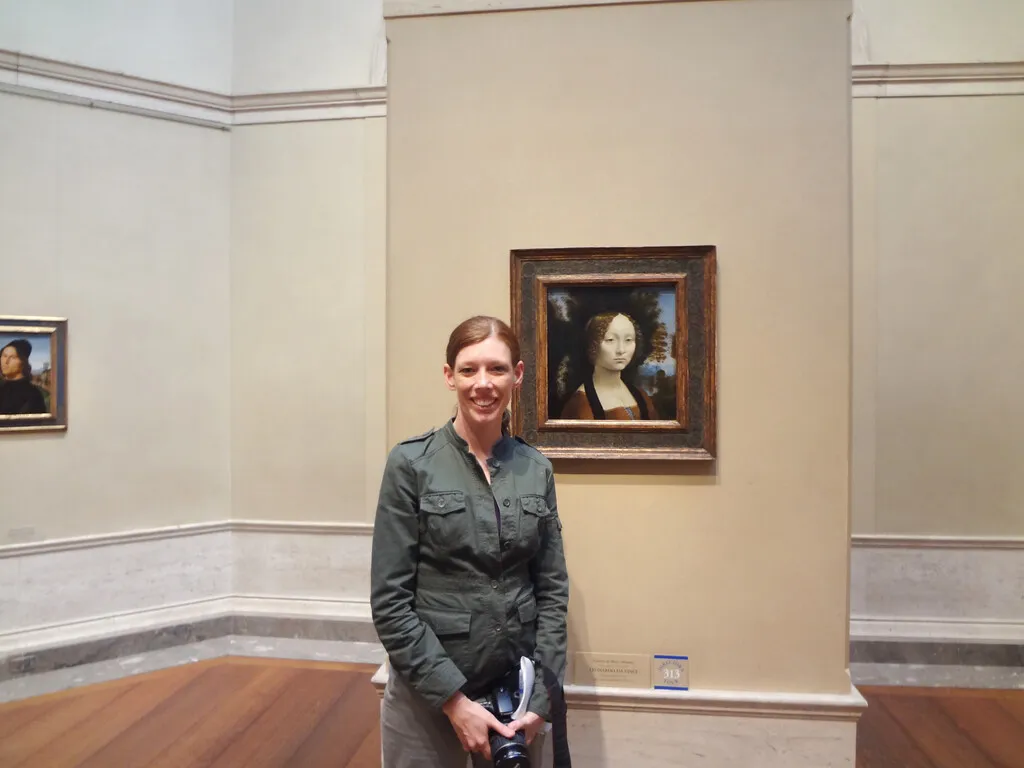
Leonardo Da Vinci
Ginevra de Benci, 1474


Byzantine artist
Enthroned Madona and Child, 1280
Let's start with oldest painting on the tour. This was done by a Byzantine (Eastern Roman Empire) artist in 1280.
It is tempera on wood. Tempera is a method of using, egg yolk and colored pigments to as the paint medium. This method was used until the 1400s when oil painting gained popularity.
In 1280 paintings were used as decoration for churches and there for the paintings during this time were religious in nature as we see with this Madonna and child.
There is a lot of symbolism in this painting let's talk about the colors. The gold represents the light of god, and the gold leaf would reflect candlelight. The blue that Mary is wearing is considered sacred and is very valuable. The blue color is made from lapis lazuli and was very costly and rare. The red of Christ's robe represents the blood of Christ and his sacrifice.

In just 40 years we see wonderful improvements to this same subject of Madona and Child. Giotto (Giotto di Bondone- 1266-1276 near Florence, Italy) is known as the father of European painting.
Here you can see how the people look more realistic. Jesus is holding his mother's finger and grabbing for the flower like a child. The flower is a white rose and is a symbol of Mary's purity.
This panel was the central panel of a larger altarpiece.
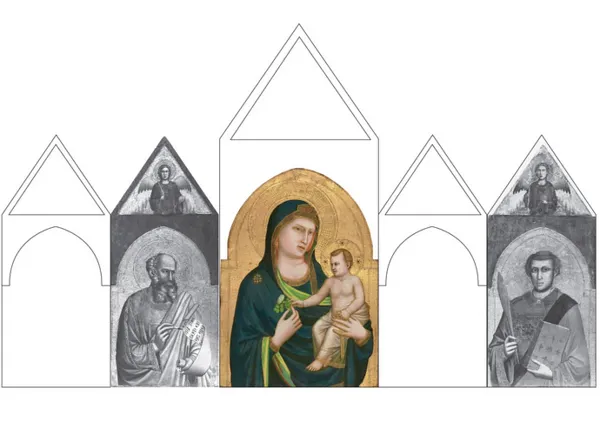
Now let's look at some of the similarities to the previous painting. The method was tempra and the gold leaf is still a major part of the painting.

Giotto
Madonna and Child, 1320

When they had heard the king, they departed; and, lo, the star, which they saw in the east, went before them, till it came and stood over where the young child was.
When they saw the star, they rejoiced with exceeding great joy.
And when they were come into the house, they saw the young child with Mary his mother, and fell down, and worshiped him: and when they had opened their treasures, they presented unto him gifts; gold, and frankincense, and myrrh
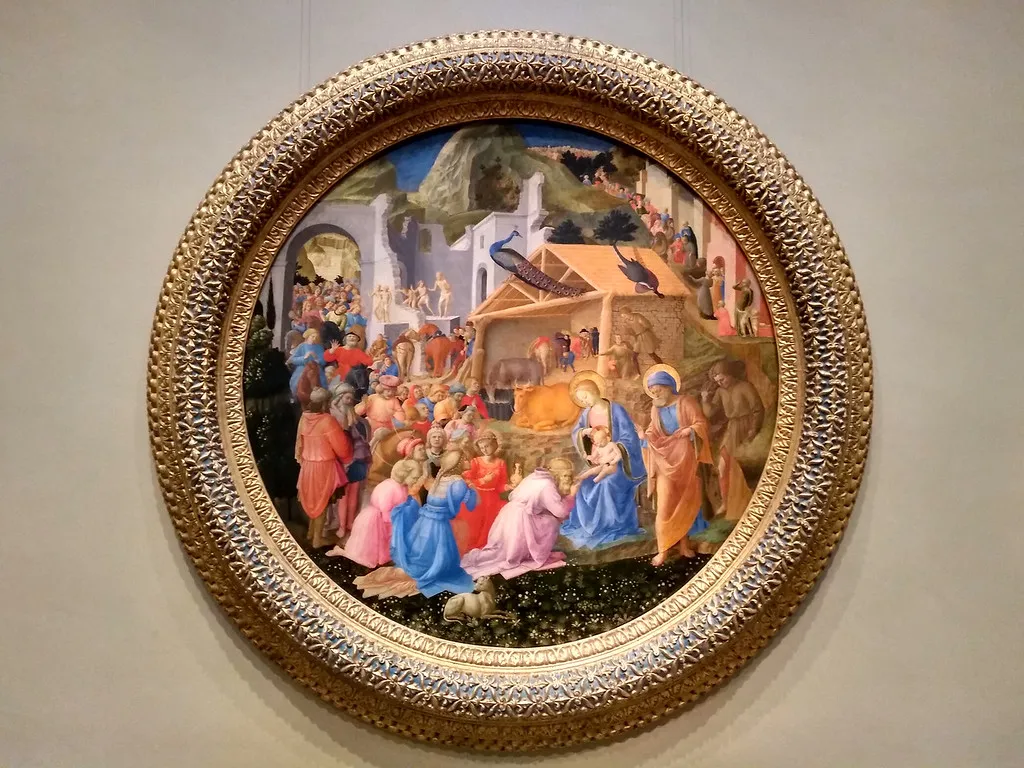
Fra Angelico and Fra Filippo Lippi
The Adoration of the Magi, 1440/1460
There are many things that I like about this painting.
- Two Friars painted this piece.
- That is a tondo or circular painting.
- That it was owned by the great Lorenzo De Medici
Again as in with the other paintings there is rich symbolism. The peacock is a symbol of immortality. The colors are bright and the details like the flowers are gorgeous.

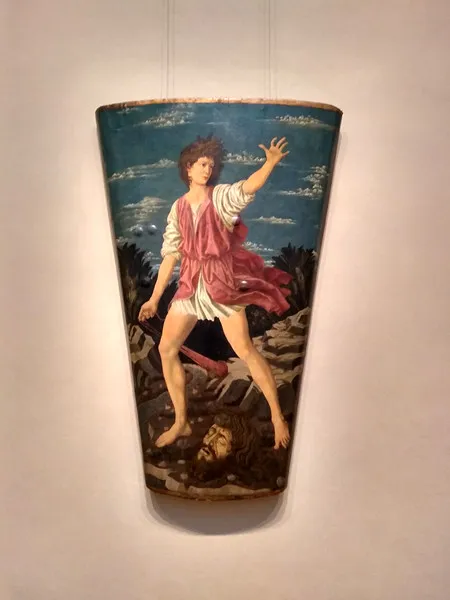
Andrea del Castagno
David with the Head of Goliath, 1450/1455
David is the symbol of Florence.
During the 1400s when Andrea del Castagno painted this scene. Florence was a new an emerging power in Italy and felt like David from the Bible a young shepherd boy versus the Goliaths such as the Pope in Rome, the Duke of Milan, the King of Naples and the Doge of Venice.
50 years later Michelangelo sculpted The David. For more on this David see my post Art Talk: Tour of the Galleria dell' Accademia...where The David is currently located.
This painting is very unique in that is painted on shield. It is also showing two different times in the story.
- When David had the stone and was about to sling it at Goliath.
- After he had slain Goliath with his head at David's feet.

 |  | 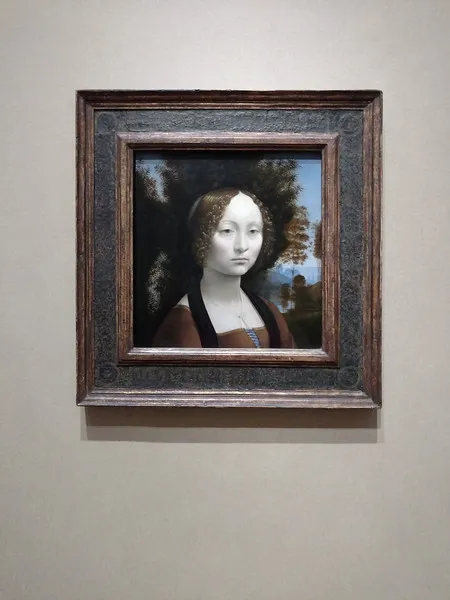 |
|---|
Leonardo Da Vinci
Ginevra de Benci, 1474
As I mentioned before this is one of my very favorite pieces in the gallery and I take a picture of it each time I go to the gallery. You can see the quality of the cameras/ phones has differed throug the years.
The level of detail and how life like she looks is astounding. The is the first painting on the tour that is painted with oil on wood instead of tempera.
The other great thing is that the painting has a reverse side. In the gallery you can see both sides. This is a emblematic portrait of Ginevra. The Latin says "Beauty Adorn Virtue". The juniper symbolized her name, the laurel and palm symbolize her intellectual and more virtue.
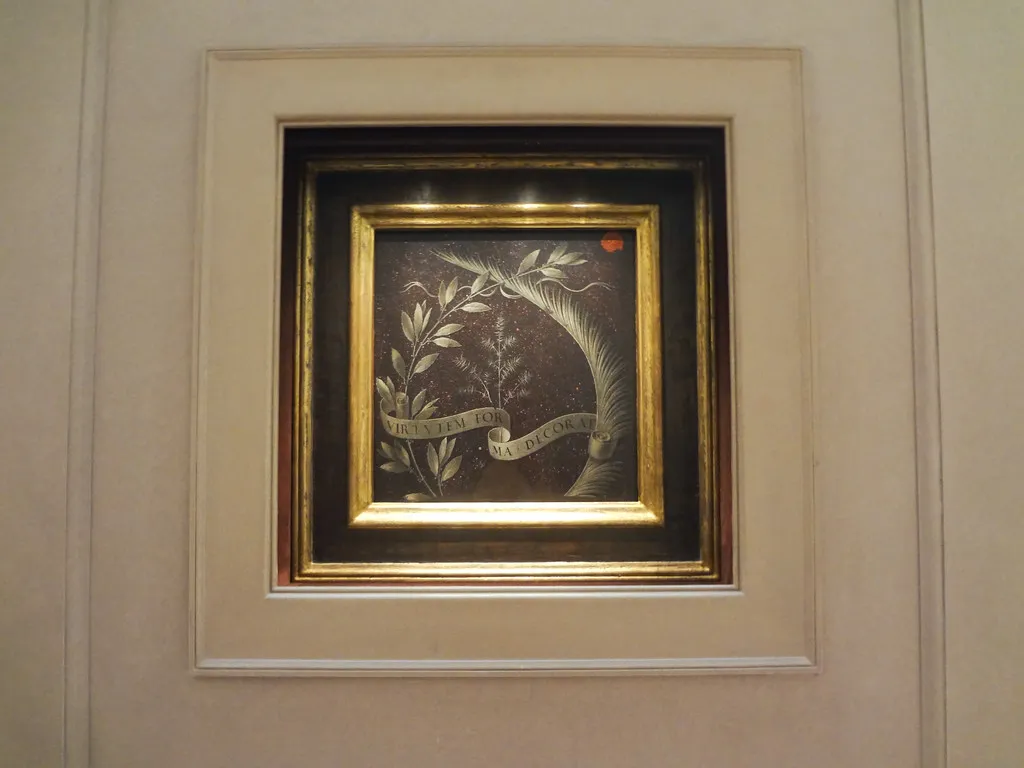
Ginevra was the daughter of a wealthy Florentine banker and was probably commissioned about the time of her marriage at 16 years old.

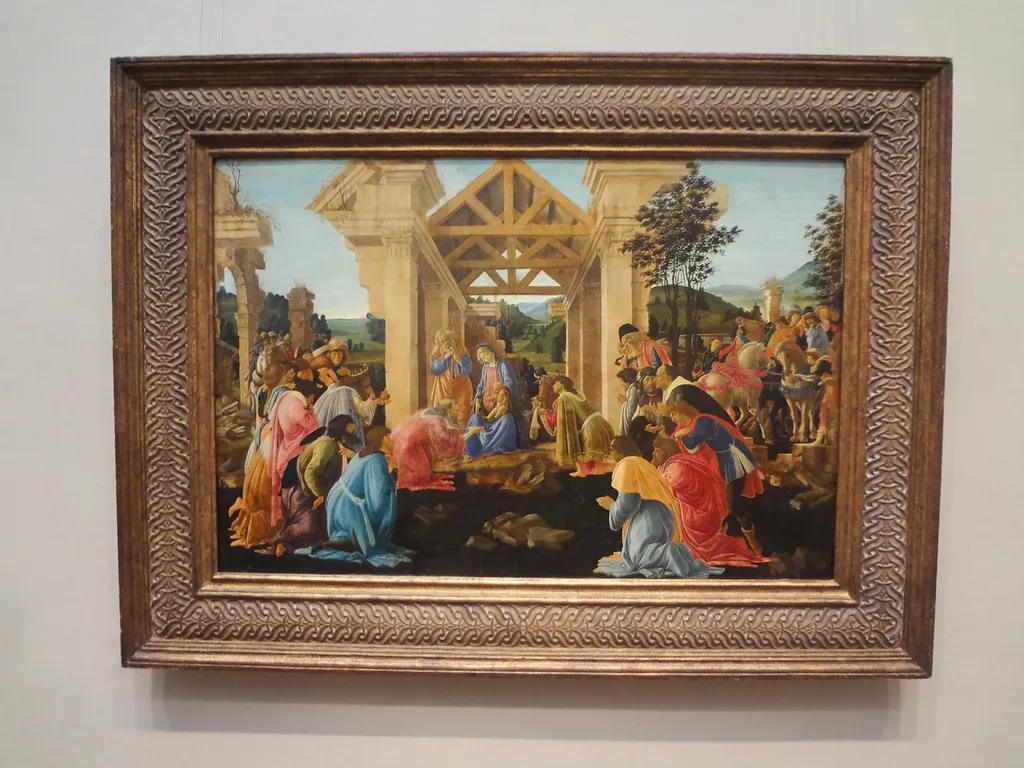
Sandro Botticelli
The Adoration of the Magi, 1478/1482
Earlier in the tour we looked at Filippo Lippi's Adoration of the Magi which was painted 1440/1460. Sandro Botticelli entered Fra Filippo Lippi's workshop toward the end of the 1450s and would have seen and been influenced by his master's painting.
This adoration scene is set in a classical Roman structure instead of a stable in Jerusalem and most likely painted while Botticelli was in Rome where he was called to fresco the Sistine Chapel.

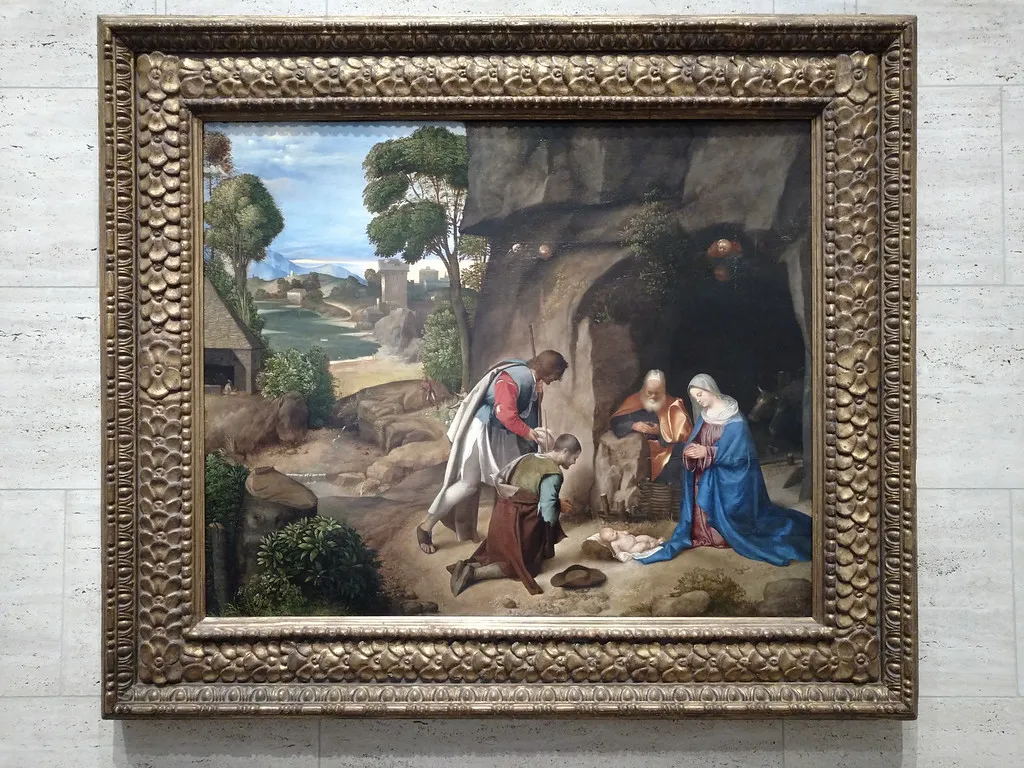
Giorgione
The Adoration of the Shepherds, 1505/1510
Girogione is another great Renaissance painter and is from Venice, Italy. It is thought that he died in 1510 the same year as this painting during a plague epidemic around the age of 32. He lived the same time as Leonardo Da Vinci, Michelangelo and Raphael. Titan whom we are going to see at the end of the tour is one of his pupils.
Continuing our theme of religious paintings. This is beautiful adoration painting with Mary and Joseph also adoring the Christ child. This is a painting of many contrasts- the dark of the cave vs the light of the landscape scene, the regal robes of Mary and Joseph vs the tattered garments of the shepherds. In person one of my favorite parts of this painting is the beautiful details of the cloth.


Raphael
The Alba Madonna, 1510
This painting by Raphael is interesting to compare to our first painting from the Byzantine artist 230 years previous. You can see here that Madonna is not on a throne instead out in a field and sitting on the ground. Another difference is the addition of Jesus cousin John the Baptist who is handing Christ a cross and all three figures are looking at the cross, as if foreshadowing what is to come. Also in this painting Mary is wearing the symbolic colors of both the red and blue.
Here we have another tonto or round format was popular in Florence at the time.


Titian
Venus with a Mirror, 1555
Most of the artists on this tour have been Florentine artists with the exception of Titian and Giorgione (who painted the Adoration of the Shepherds) who are both from Venice, Italy. Titian dominated painting in Venice during his lifetime. He painted portraiture, religious and like we see here mythological paintings.
Venus is the goodness of love and beauty and this it the ideal beauty in 1555 according to Titan. It is interesting to me to see beauty created by great masters that have survived the ages.
Titan kept this painting in his possession for more than 20 years and until his death.
Titian was really a master artist and this really is an amazing painting of textures. The red velvet cloth on her lap, the braids in her hair, her jewels and most impressive her skin that looks like you can touch it.
I hope you enjoyed this Italian Renaissance tour of the National Gallery of Art in Washington, DC. It was the first tour I designed. It is fun to share it.
Next week will go into more detail about the great Renaissance artist Raphael.

Sources
A Brief History of Gold's Symbolism in Art
Why Jesus and Mary Always Wear Red and Blue in Art History
National Gallery of Art- Madonna and Child, Giotto
National Gallery of Art- The Adoration of the Magi
National Gallery of Art- Ginervra de Benci- Obverse
National Gallery of Art- Ginervra de Benci- Reverse
National Gallery of Art-David with the Head of Goliath
National Gallery of Art-The Adoration of the Magi
National Gallery of Art-The Adoration of the Shepherds
National Gallery of Art-The Alba Madonna
National Gallery of Art-Venus with a Mirror
Art Talk Series Highlights
2020
Art Talk: Recycled Plastic Art Movement
Art Talk: Gates of Paradise
March- Italian Renaissance
2018
Art Talk: Introduction
Art Talk: Emotion in Bronze
Art Talk: Moore Across America
Art Talk: Bronze
Art Talk: Moore in America
Art Talk: King and Queen
Art Talk: Art Tells Our Story
Art Talk: Highlight Tour of the MET
Art Talk: The Burghers of Calais
Art Talk: Auguste Rodin
Art Talk: Art in Paris in the 1870s
Art Talk: Guest Blogger, Frankie O'Neill
Art Talk: "Felt is a happy fabric."
Art Talk: Murals in Klamath Falls
Art Talk: Woman with a Parasol- Madame Monet and Her Son
Art Talk: Respect and Compassion
2019
Art Talk: Art Connects Us
Art Talk: My mother's crystal
Art Talk: Mother and Child
Art Talk: Tour of the Galleria dell' Accademia
Art Talk: Walking tour of Florence, Italy
Art Talk: Chihuly at the Oklahoma City Museum of Art
Art Talk: Vatican tour highlights
Art Talk: Ceilings in the Vatican
Art Talk: Chihuly at Kew Gardens
Art Talk: MET Highlight tour
Art Talk: Japan at the MET
Art Talk: Up Close with French art at the National Gallery of Art in DC
Art Talk: Kelpies
Art Talk: Buying from local artists
Art Talk: Guest Blogger, Joia Doiron
Haveyoubeenhere 2019 Steemitworldmap travel contest- Four Wonderful Museums
